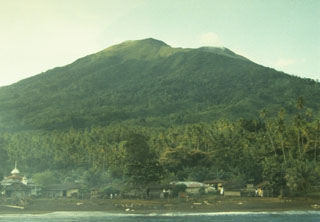Report on Gamkonora (Indonesia) — July 1981
Scientific Event Alert Network Bulletin, vol. 6, no. 7 (July 1981)
Managing Editor: Lindsay McClelland.
Gamkonora (Indonesia) Tephra ejection; more than 3,500 flee briefly
Please cite this report as:
Global Volcanism Program, 1981. Report on Gamkonora (Indonesia) (McClelland, L., ed.). Scientific Event Alert Network Bulletin, 6:7. Smithsonian Institution. https://doi.org/10.5479/si.GVP.SEAN198107-268040
Gamkonora
Indonesia
1.38°N, 127.53°E; summit elev. 1635 m
All times are local (unless otherwise noted)
Explosive activity from the summit crater began about 0900 on 19 July. The eruption apparently began with the ejection of incandescent tephra, followed by about 1.5 hours of ash emission. An eruption cloud rose about 700 m and ash fell 5 km S of the summit, where 1-1.5 mm accumulated. Occasional felt earthquakes continued after the 19 July ash ejection ended. More than 3,500 people fled the area.
Smaller explosions occurred on 22 July at about 0400 and 1800, accompanied by booming noises heard in a village at the NNW foot of the volcano, 5 km from the summit. Glow was visible over the crater at night. A VSI team arrived on the island immediately after the second explosion. After the team issued an evaluation, the evacuees returned to their homes. Local officials reported that the summit crater had occasionally emitted thick "smoke" since March.
Geological Summary. The shifting of eruption centers on Gamkonora, the highest peak of Halmahera, has produced an elongated series of summit craters along a N-S trending rift. Youthful-looking lava flows originate near the cones of Gunung Alon and Popolojo, south of Gamkonora. Since its first recorded eruption in the 16th century, typical activity has been small-to-moderate explosive eruptions. Its largest recorded eruption, in 1673, was accompanied by tsunamis that inundated villages.
Information Contacts: A. Sudradjat, S. Suparto, Suratman, VSI; Antara News Agency, Jakarta; AFP.

